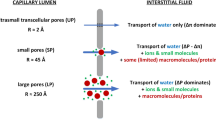Abstract
The two phase (vascular-extravascular) Sangren-Sheppard (SS) model is often used to estimate capillary permeability-surface area product (PS) from multiple indicator data. Our objective was to identify conditions where erroneous estimates of capillary PS or extravascular volume (VE) result from the application of this model to data obtained from non-homogeneous capillary units. We used a 4-phase capillary-tissue model (plasma, erythrocytes, interstitial fluid and extravascular cellular fluid) to simulate data collected from a heterogeneous capillary unit. A moment-matching technique was used to compute the parameters of the simpler SS model which would adequately describe the 4 phase tracer concentration-time (c(t)) curve. Deviations of computed values of VE and PS from the PS and extravascular volume specified in the 4-phase model were determined as functions of dimensionless red cell permeability αRC, hematocrit value, plasma-to-red cell velocity ratio, dimensionless extravascular cellular volume and permeability, capillary permeability αcap, and the fraction of indicator orginally deposited in the plasma at the capillary inlet. Our results indicate that application of the SS model to simulated low capillary permeability data produces underestimates in both VE and PS. Equations are presented which correct for this effect so long as the SS and 4-phase model c(t) curves are similar. Application of the whole blood-tissue SS model in situations where red cells are only slightly permeable or use of the plasma-tissue SS model when red cells admit tracer can lead to significant errors in VE and PS estimates. When αcap is relatively large neither SS model yields an accurate estimate of PS in the intermediate αRC range (i.e., near unity). Less than 10% error will result, regardless of αRC, if the blood-tissue SS model is used (αcap ≤ .30, Hct≤.50) and the tracer is equilibrated with a blood sample before injection.
Similar content being viewed by others
References
Aris, R. On the dispersion of a solute in a fluid flowing through a tube.Proc. R. Soc. London, Series A. 235:67–77, 1956.
Bassingthwaighte, J. B. A concurrent flow model for extraction during transcapillary passage.Circ. Res. 35:483–503, 1974.
Bird, R. B., W. E. Stewart, and E. N. Lightfoot.Transport Phenomena. New York: Wiley, 1960.
Brigham, K. L., T. R. Harris, and P. J. Owen.14C-sucrose as permeability indicators in histamine pulmonary edema.J. Appl. Physiol: Respiratory, Environment, and Exercise Physiology. 43: 99–101, 1977.
Brigham, K. L., T. R. Harris, R. D. Rowlett, and P. J. Owen. Comparisons of14C-urea and3H-mannitol as lung vascular permeability indicators in awake sheep: Evidence against red cell trapping.Microvasc. Res. 13:97–105, 1977.
Chinard, F. P., C. A. Goresky, T. Enns, M. F. Nolan, and R. W. House. Trapping of urea by red cells in the kidney.Am. J. Physiol. 209:253–263, 1965.
Goresky, C. A., G. G. Bach, and B. E. Wangel. Indicator dilution measurements of extravascular water in the lungs.J. Clin. Invest. 48:487–501, 1969.
Goresky, C. A., W. H. Ziegler, and G. G. Bach. Capillary exchange modeling: Barrier limited and flow limited distribution.Circ. Res. 27:739–764, 1970.
Harris, T. R., K. L. Brigham, and R. D. Bowlett. Pressure, serotonin and histamine effects on lung multiple-indicator curves in sheep.J. Appli. Physiol. 44:245–253, 1978.
Harris, T. R., C. A. Gervin, D. Burks, and P. L. Custer. Effects of coronary flow reduction on capillary-myocardial exchange in dogs.Am. J. Physiol: Heart and Circulation. 3:H679-H689, 1978.
Harris, T. R., R. D. Rowlett, and K. L. Brigham. The identification of pulmonary capillary permeability from multiple indicator data. Effects of increased capillary pressure and alloxan treatment in the dog.Microvasc. Res. 12:177–196, 1976.
Lassen, N. A. and C. Crone. Extraction fraction of a capillary bed to hydrophilic molecules: Theoretical considerations regarding the single injection technique with a discussion of the role of diffusion between laminar streams (Taylor's effect). In:Capillary Permeability. Alfred Benzon Symposium II, edited by C. Crone and N. A. Lassen. Copenhagen: Munksgaard, 1970, pp. 48–59.
Perl, W. Red cell permeability effect on the mean transit time of an indicator transported through an organ by red cells and plasma.Circ. Res. 36:352–357, 1975.
Rose, L. P., C. A. Goresky, and G. G. Bach. The capillary and sarcolemmal barriers in the heart: An exploration of labeled water permeability.Circ. Res. 41:515, 1977.
Roselli, R. J. and K. L. Brigham. Effect of red cell capillary exchange on the calculation of sheep lung urea vascular permeability.Fed. Proc. 35:443, 1978.
Roselli, R. J. and T. R. Harris. A four-phase model of capillary tracer exchange.Ann. Biomed. Eng. 7:203–238, 1979.
Rowlett, R. D., and T. R. Harris. A comparative study of organ models and numerical techniques for the evaluation of capillary permeability from multiple-indicator data.Math. Biosci. 29:273–298, 1976.
Sangren, W. C. and C. W. Sheppard. Mathematical deviation of the exchange of a labeled substance between a liquid flowing in a vessel and an external compartment.Bull. Math. Biophys. 15:387–394, 1953.
Sheehan, R. M. and E. M. Renkin. Capillary interstitial and cell membrane barriers to blood-tissue transport of potassium and rubidium in mammelian skeletal muscle.Circ. Res. 30:588–607, 1972.
Taylor, G. I. Dispersion of soluble matter in a solvent flowing slowly through a tube.Proc. R. Soc. London, Series A. 219:186–203, 1953.
Yudilevich, D. L. Serial barriers to blood-tissue transport studied by the single injection indicator diffusion technique. In:Capillary Permeability, Alfred Benzon Symposium II, edited by C. Crone and N. A. Lassen. Copenhagen: Munksgaard, 1970, pp. 115–128.
Ziegler, W. H. and C. A. Goresky. Transcapillary exchange in the working left ventricle of the dog.Circ. Res. 24:181–207, 1971.
Ziegler, W. H. and C. A. Goresky. Kinetics of rubidium uptake in the working dog heart.Circ. Res. 24:208–220, 1971.
Author information
Authors and Affiliations
Additional information
Supported by NHLBI Grant No. HL 19153 (SCOR in Pulmonary Vascular Diseases).
This work was done during Dr. Roselli's tenure as an NHLBI Training Grant Fellow (NHLBI Training Grant No. 07123).
Rights and permissions
About this article
Cite this article
Roselli, R.J., Harris, T.R. The effects of red cell and tissue exchange on the evaluation of capillary permeability from multiple indicator data. Ann Biomed Eng 7, 239–282 (1979). https://doi.org/10.1007/BF02364116
Issue Date:
DOI: https://doi.org/10.1007/BF02364116




